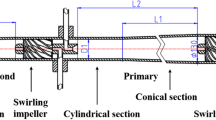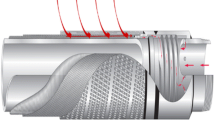Abstract
Oil and gas industry faces new challenges these days: new off-shore fields are located in harsher environments, at longer distances from shore, in deeper waters, demanding more compact and efficient process facilities, to optimize investment costs and then, to guarantee the economic feasibility of these new projects. On the other hand, brown fields with decaying production experience significant changing process conditions which usually impose constrains in existing facilities. The bottlenecking of these facilities requires process improvements to increase their capacity and efficiency, minimizing at the same time any production deferment which could translates into unwanted higher operational costs. Usually, in both cases there are severe space limitations to deploy solutions, demanding these solutions to become more and more compact. PDVSA-Intevep has identified the need for a compact, high efficiency, and high capacity separation technology to address potential gas scrubbing problems in both green and brown fields, and started the development of an axial gas liquid cyclone as an answer to these needs. The separator consists of a flow conditioning section, a swirl generator section, and a segregating section with a discharge for gas and liquid phases in the outlet. An extensive planning, design, construction, and further experimental validation process of a prototype was conducted in the multiphase flow loop facilities of PDVSA-Intevep to demonstrate the axial cyclone concept. As a result of the experimental validation, several aspects of geometrical design were identified to be susceptible to improvements in order to achieve target separation efficiency. The geometric variables identified and addressed in order to improve the performance of this equipment are: incorporating a pre-separation chamber to remove segregated flow incoming to the device, a static mixer to homogenize the gas liquid mixture incoming to the swirl generator, of swirl generator configuration for constructability purposes, improvement of the liquid annular outlet, gas recycle, and outlet gas flow conditioner configurations. The new design is the result of a comprehensive process of revisiting and evaluating the state-of-the-art of axial separation technologies, incorporating lessons learned during the concept demonstration tests and mechanistic modelling of the prototype. Design was conducted considering the operating envelope of the multiphase flow loop of PDVSA-Intevep, to carry out an experimental performance assessment of the incorporated improvements.
Access this chapter
Tax calculation will be finalised at checkout
Purchases are for personal use only
Similar content being viewed by others
References
Austrheim T (2006) Experimental characterization of high-pressure natural gas scrubbers. Ph.D. Thesis, Univertsity of Bergen, Norway.
Barbuceanu N, Scott S (2001) Novel inlet design expands range of operability for compact separator. In: SPE annual technical conference and exhibition, New Orleans, Louisiana, 30 September-3 October 2001, paper SPE 71555.
Chin RW, Stanbridge DI, Schook R (2002) Increasing separation capacity with new proven technologies. In: SPE annual technical conference and exhibition, San Antonio, Texas, 29 September-2 October 2002, San Antonio, paper SPE 77495.
Delgado G (2010) Test bench scale evaluation of an axial cyclonic scrubber prototype development by PDVSA Intevep. Universidad Central de Venezuela, Venezuela, Thesis
Demey H, Trujillo J (2008) Conceptual design of a scrubber axial flow cyclone gas-liquid. Universidad de Carabobo, Venezuela, Thesis
Dickson PJ (1998) Gas/Liquid separation within a novel axial flow cyclone separator. Ph.D. Thesis, School of Mechanical Engineering, Cranfield University, UK.
Frankiewicz T, Browne M, Lee CM (2001) Reducing separation train sizes and increasing capacity by application of emerging technologies. In: Offshore technology conference, Houston, Texas, 30 April-3 May 2001, paper OTC 13215.
Gómez L (1998) A state of the art simulator and field application design of gas-liquid cylindrical cyclone separators. The University of Tulsa, USA, Master Thesis
GPSA (1998) Engineering Data Book, FPS Version, Vol. I.
Hoffman A, Stein L (2002) Gas cyclones and swirl tubes: principles: design and operation. Springer-Velarg, Berlin
PDVSA (2011) Annual management report. Ministerio del Poder Popular para la Energía y Petróleo, Venezuela
Rawlins CH (2003) The case for compact separation. Technology Today Series, paper SPE 80994:77–80
Ruiz R, Trujillo J, López J (2009) Design of a test bench prototype of an axial cyclonic separation technology for high gas-liquid Ratio. Technical Report INT-12922, Intevep, Los Teques, Venezuela.
Swanborn RA (1988) A new approach to the design of gas-liquid separators for the oil industry. PhD Thesis, Delf University of Technology, The Netherlands.
Thakur RK, Vial C, Nigam KDP, Nauman EB, Djelveh G (2003) Static mixers in the process industries–a review. Chem Eng Res Des 81:787–826
Ulloa J, Trujillo J (2007) Frontiers and trends identification of axial gas-liquid cyclonic separation. Technical Report SIT-0362-2007, Intevep, Los Teques, Venezuela.
Verlaan CCJ (1991) Performance of novel mist Eliminators. Ph.D. Thesis, Delf University of Technology, The Netherlands.
Author information
Authors and Affiliations
Corresponding author
Editor information
Editors and Affiliations
Rights and permissions
Copyright information
© 2014 Springer International Publishing Switzerland
About this chapter
Cite this chapter
Peréz Guerra, L.D., Trujillo , J., Blanco, W. (2014). Geometric Design Optimization of a Prototype Axial Gas-Liquid Cyclonic Separator. In: Sigalotti, L., Klapp, J., Sira, E. (eds) Computational and Experimental Fluid Mechanics with Applications to Physics, Engineering and the Environment. Environmental Science and Engineering(). Springer, Cham. https://doi.org/10.1007/978-3-319-00191-3_27
Download citation
DOI: https://doi.org/10.1007/978-3-319-00191-3_27
Published:
Publisher Name: Springer, Cham
Print ISBN: 978-3-319-00190-6
Online ISBN: 978-3-319-00191-3
eBook Packages: Earth and Environmental ScienceEarth and Environmental Science (R0)




